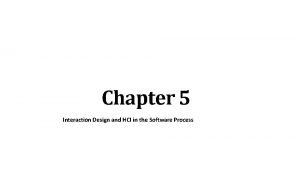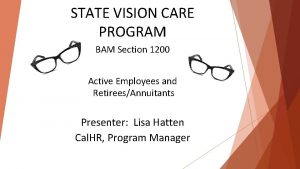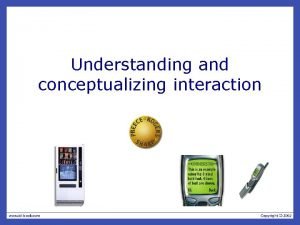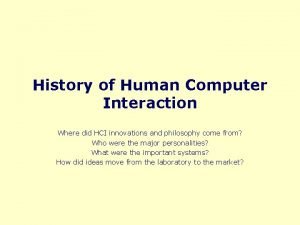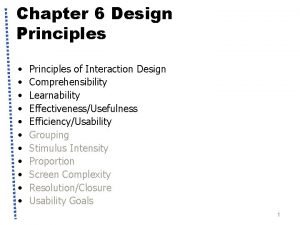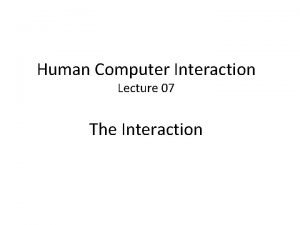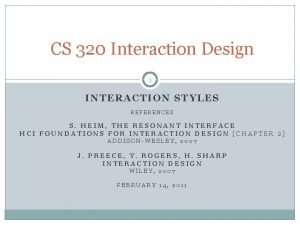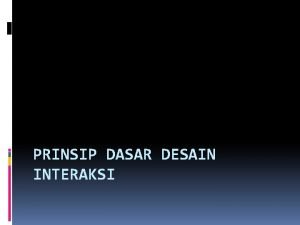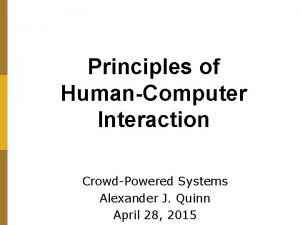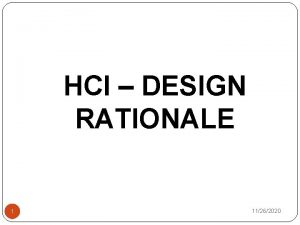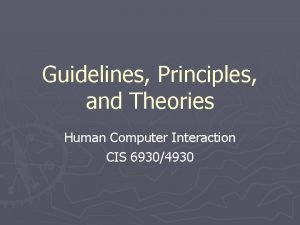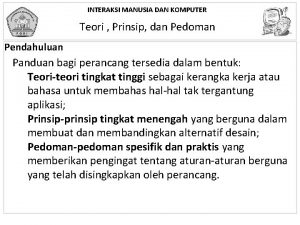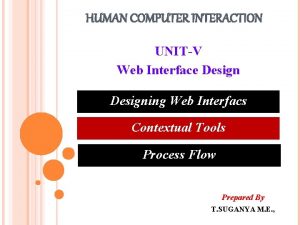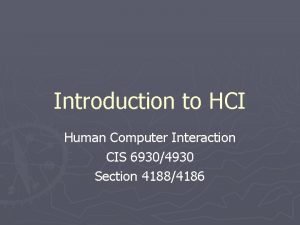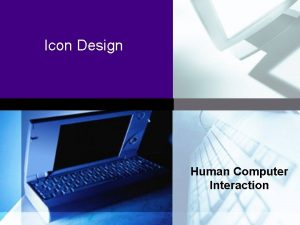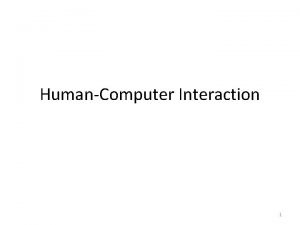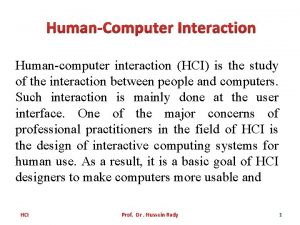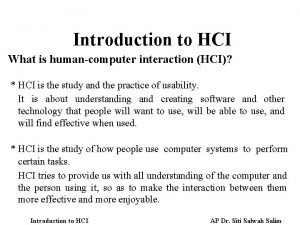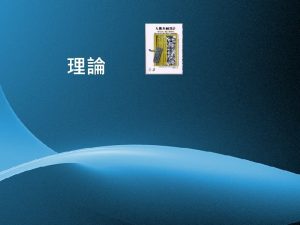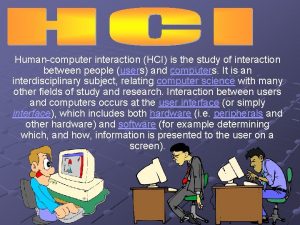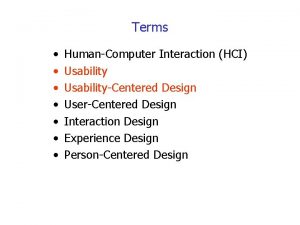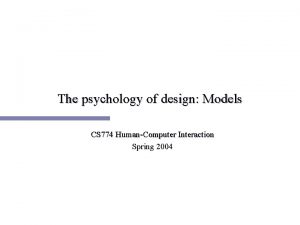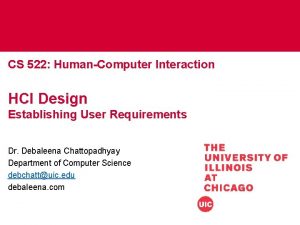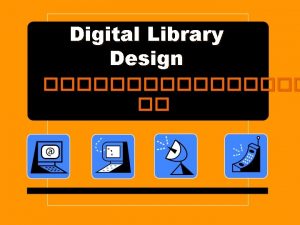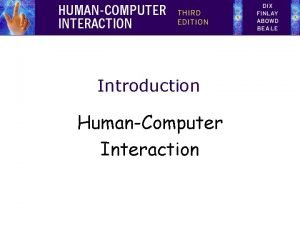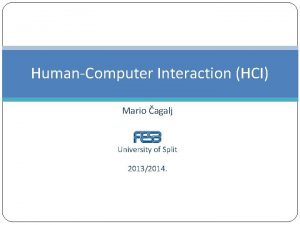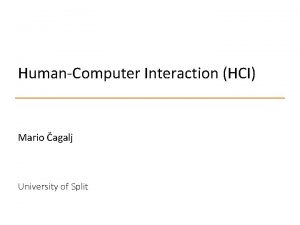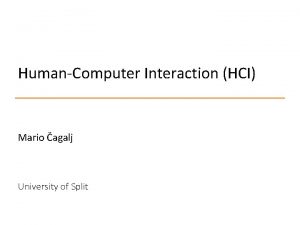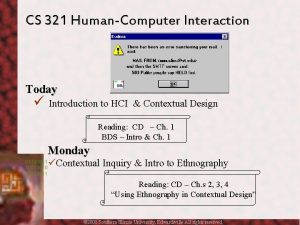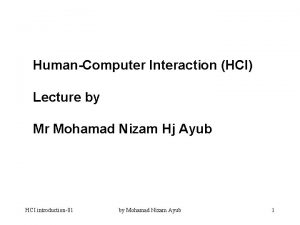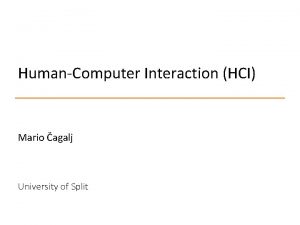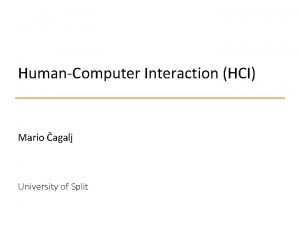Principles of HCI Design CS 774 HumanComputer Interaction

























- Slides: 25

Principles of HCI Design CS 774 Human-Computer Interaction Spring 2004

HCI Design Principles n Design involves choices – Big choices - primary interaction styles – Little choices - button label, color, position n HCI design is art, not science – No algorithm to make choices for you n Principles help make choices – Heuristics -- rule of thumb, wise guess – etymology: from Greek heuriskein to discover, to find CS 774 HCI Spring 2004

Proliferation of Principles n n n Shneiderman - 3 principles, 8 golden rules Norman - 7 principles Borenstein - 10 commandments Mandel - 3 golden rules Johnson (GUI Bloopers) - 9 principles, 82 bloopers and rules to prevent them How to learn what everyone has to say? CS 774 HCI Spring 2004

What have we learned so far? n Knowledge in the world – Books, notes, bookmarks - organize the world n Magic number 7 – Keep the number in mind small n Learn – Accommodate/assimilate/habituate n Mnemonics – Use patterns, mental images, to organize your mind CS 774 HCI Spring 2004

Principles vs. Guidelines n General Principles – – – n Applicable to many interface systems Big and small designs Verified by research experience Widget Guidelines – – Designed for specific GUI systems Gives grammar and vocabulary for interface Mostly for smaller decisions Apple, Windows, Java guidelines CS 774 HCI Spring 2004

Process vs. Usability n Process principles – Such as make prototypes, involve user, etc. – Focuses on what you do n Usability principles – – – Such as provide feedback, be consistent, etc. Focuses on what you create Good for evaluation of interface CS 774 HCI Spring 2004

Chapter 2 Principles n Principle 1: Recognize the diversity – Characterize users, tasks and interaction styles – Foreshadows rest of book - will get back to n Principle 2: Use the Eight Golden Rules – Will do now n Principle 3: Prevent Errors – Your homework CS 774 HCI Spring 2004

1. Strive for Consistency n n n Make the elements of your interface consistent. What elements? Consistent with what? CS 774 HCI Spring 2004

Consistency n With what? – – – n Within your own program? With other programs? With the user’s experience in the world? What elements? – – – Actions Widgets Data CS 774 HCI Spring 2004

2. Enable shortcuts n n Let the interface grow with the user How? CS 774 HCI Spring 2004

Shortcut options n Keyboard short cuts Toolbars Re-configurable menus and toolbars n Alternative representations n n CS 774 HCI Spring 2004

A counter opinion n Jeff Raskin – One button mouse – Monotonous interfaces - only one way to do X n Multiple options can result from – – – n Legacy options Management indecision (oh, include them all) Myth of beginner/expert users Current GUIs mix of two inferior interfaces – Inefficient menu system + incomplete keyboard system CS 774 HCI Spring 2004

3. Offer informative feedback n n Let the user know what happened How? CS 774 HCI Spring 2004

Feedback n Responsiveness – Do it quickly – If it’s going to be a while, tell the user – Use watch cursors, progress bars n n When? What is a complete action to report on? How? – Change appearance of object (WYSIWYG) – Dialog boxes – Status of interface (grey out menu items, highlight, etc) CS 774 HCI Spring 2004

4. Design for closure n n Let the user know the task is done How? CS 774 HCI Spring 2004

Computers as Theatre n n n Brenda Laurel - started as game designer Computer Screen as stage on which we enact scripts Think of interface in terms of – Narrative flow - beginning, middle, end – Actors/Agents - who saved your file? Who gave you the error message? – Stage with actors carrying out an action CS 774 HCI Spring 2004

5. Offer error prevention n n Design the system to prevent errors How? CS 774 HCI Spring 2004

Avoid errors - control input n n n Grey out inappropriate commands Forcing functions Control field input – No letters in number field n Know causes/ frequency CS 774 HCI Spring 2004

Responding to errors n n n Error messages should be in user’s language Actions should be clear Avoid guessing user intent – PL/I and parens n Do nothing (? ? ? ) CS 774 HCI Spring 2004

6. Permit easy reversal n n Let the user undo actions How and why? CS 774 HCI Spring 2004

Easy undos n Allow the user to feel safe – Less risk of damaging data – (Why is data ever damaged? Why not retain everything? Problem of the Mac trash can. ) n n n Correct errors Allow experimentation How – Revert to saved, undo (how long? What is a single action? ), automatic backup files CS 774 HCI Spring 2004

7. Support internal locus of control n n Keep the user in control How? CS 774 HCI Spring 2004

User in control n n Avoid modal dialogs (with Java threads!) Avoid long guided sequences Be permissive Provide exits – Cancel, undo, interrupt, quit CS 774 HCI Spring 2004

8. Reduce short-term memory load n n Magic number 7+/-2 How do we manage this? CS 774 HCI Spring 2004

Reducing memory load n n Rely on recognition, not memory (see and point) Provide cues (affordances, toolbars, menus) Visual clarity (Greek temple, not strip mall) Progressive disclosure (hide advanced stuff) CS 774 HCI Spring 2004
 Formality gap in hci
Formality gap in hci Calhr 695
Calhr 695 Nye nyogel 760g
Nye nyogel 760g Interaction styles in hci
Interaction styles in hci Don norman 7 stages of action
Don norman 7 stages of action Models of interaction in hci
Models of interaction in hci These are more suitable medium than paper.
These are more suitable medium than paper. History of human computer interface
History of human computer interface Interaction framework in hci
Interaction framework in hci Emotional interaction
Emotional interaction Flight level
Flight level Elements of wimp
Elements of wimp Interaction styles
Interaction styles Prinsip dasar desain interaksi
Prinsip dasar desain interaksi Principles of flexibility in hci
Principles of flexibility in hci Principles of hci
Principles of hci Robustness in hci
Robustness in hci Hci theories and principles
Hci theories and principles Yang termasuk model antarmuka objek-aksi
Yang termasuk model antarmuka objek-aksi Process flow of web interface design in hci
Process flow of web interface design in hci Define universal design in hci
Define universal design in hci Common device with substantial hci design
Common device with substantial hci design Icons in hci
Icons in hci Screen design and layout in hci
Screen design and layout in hci Hci design patterns
Hci design patterns Four pillars of design in hci
Four pillars of design in hci
